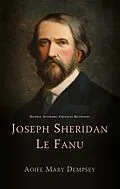This book considers the fiction of Joseph Sheridan Le Fanu (1814-73) in its original material and cultural contexts of the early-to-mid Victorian period in Ireland. Le Fanu's longstanding relationship with the Dublin University Magazine, a popular literary and political journal, is crucial in the examination of his work; likewise, his fiction is considered as part of a wider surge of supernatural, historical and antiquarian activity by Irish Protestants in the period following the Act of Union between Great Britain and Ireland (1801). This study discusses in detail Le Fanu's habit of writing and re-writing stories - a practice that has engendered much confusion and consternation - while posthumous collections of his work are compared with original publications to demonstrate the importance of these material and cultural contexts. In new critical readings of aspects of Le Fanu's best-known fiction, light is cast on some of his overlooked work through recontextualisation.
Autorentext
This book will be suitable for undergraduates who are interested in gothic, nineteenth century Irish literature, Victorian literature, material and publishing contexts, the Victorian literary marketplace, literary connections and influences, cultural histories, trans-national literary networks in nineteenth century, Irish postcolonial literature. It will also appeal to academic specialists either researching or teaching on Le Fanu, gothic studies, Anglo-Irish authors, Victorian publishing, and Irish writing.
Klappentext
This book considers the fiction of Joseph Sheridan Le Fanu (1814-73) in their original material and cultural contexts of the early-to-mid Victorian period in Ireland. Le Fanu's longstanding relationship with the Dublin University Magazine, a popular literary and political journal, is a crucial context in the examination of his work. Likewise, Le Fanu's fiction is considered as part of a wider surge of supernatural, historical and antiquarian activity by Irish Protestants in the period following the Act of Union between Great Britain and Ireland (1801). Le Fanu's habit of writing and re-writing stories is discussed in detail, a practice that has engendered much confusion and consternation. Posthumous collections of Le Fanu's work are compared with original publications, demonstrating the importance of these material and cultural contexts. This book reveals new critical readings of some of Le Fanu's best known fiction, while also casting light on some of his regrettably overlooked work through recontextualisation.
Inhalt
Acknowledgements Introduction: Irish Protestant Gothic and J. S. Le Fanu 1. Material Culture, Serialisation and Lateral Reading: Le Fanu's Short Stories in Context 2. Immaterial Spaces: Le Fanu's Unhomely Houses 3. Fictional Networks: Le Fanu's Literary Legacy 4. Le Fanu and the Pitfalls of Posthumous Collections Closing the Book on the Invisible Prince Appendix Bibliography Notes
